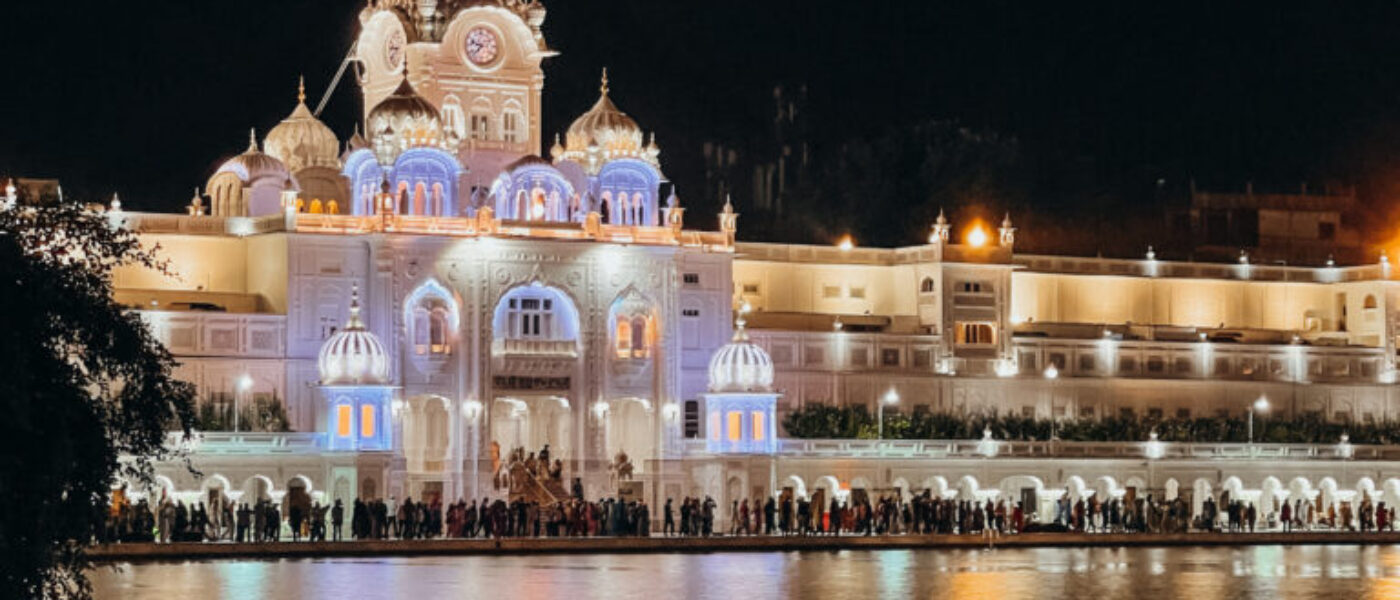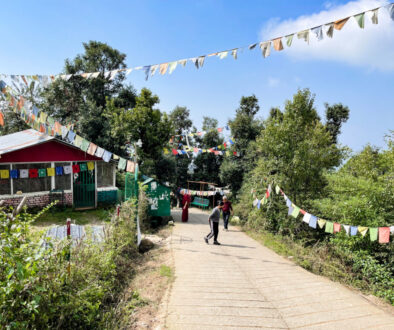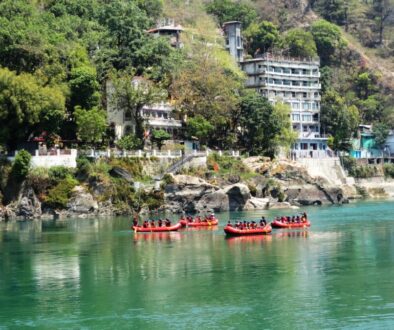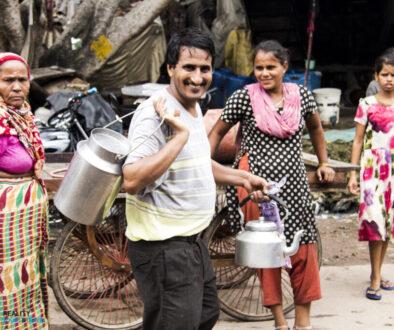While living in Delhi, I made it my mission to explore as much of India as possible by taking short weekend trips from Delhi, and after my weekend in Rishikesh, I decided Amritsar would be next. Amritsar is a city in the northwestern Indian state of Punjab, and is the spiritual center for the Sikh religion. Founded in 1577 by the fourth Sikh guru, Guru Ram Das, Amritsar is home to the Harmandir Sahib, also known as the Golden Temple. This sacred site is visited by millions of pilgrims each year, and is one of the most important pilgrimage sites for Sikhs. The temple complex also includes the Akal Takht, a seat of authority for the religion, as well as a museum and library. Amritsar is also famous for its cuisine, particularly its street food. Visitors can find delicious snacks like chaat, samosas, and kulfi all over the city. With so much to see and do in such a short period of time, here’s how I spent my weekend experiencing a taste of Punjabi culture.
Visit the Golden Temple
The golden temple Amritsar is a place of great religious importance for the Sikhs. Built in the 16th century by Guru Arjan, the temple complex is also home to a variety of other historical and cultural sites. Visitors to the complex can explore the stunning marble interior of the temple, take a dip in the holy pool, or simply enjoy the peaceful atmosphere. The golden temple is open to all visitors, regardless of their religion, and is an essential stop on any trip to India.

Amritsar’s Golden Temple is a must-see for any visitor to India. The temple is open 24 hours a day, and people can eat, pray, and sleep there. You can visit the temple at any time of day, but it’s especially beautiful at night time. The golden dome of the temple is illuminated by hundreds of lights, and the atmosphere is calm and peaceful.




Partition Museum
On August 15, 1947, India gained independence from British rule after nearly a century of struggle. However, the country was immediately plunged into chaos as religious violence broke out between Hindus and Muslims. In an effort to quell the unrest, the British viceroy, Lord Mountbatten, proposed a radical solution: the partition of India into two separate states, one Hindu and one Muslim. The plan was met with fierce opposition from both Hindus and Muslims, but it was ultimately approved by the British Parliament. On August 14, 1947, Pakistan became an independent Muslim state, and on August 15, 1947, India became an independent Hindu state. The partition of India remains one of the most controversial events in world history, and its legacy is still felt today.



The partition museum in Amritsar is a must-visit for anyone interested in the history of India. The museum tells the story of the partition of India and Pakistan, from the perspective of those who lived through it. Visitors can see firsthand accounts of the violence and suffering that accompanied the split, as well as the hope and resilience that helped people to rebuild their lives. The museum also houses a collection of artifacts from the period, including personal items, photographs, and documents. In addition to being a fascinating history lesson, the partition museum is also a reminder of the importance of tolerance and understanding.
Wagah Border Ceremony
Every day, at the Wagah border between India and Pakistan, two armies come together to perform a ceremonial display of their military prowess. The Wagah border ceremony has its origins in the British Raj, when the soldiers of the Indian Army would lower the Union Jack at sunset. After India gained independence from Britain in 1947, the lowering of the flag became a symbolic gesture of India’s sovereignty. Over time, the ceremony has become more elaborate, with both sides trying to outdo each other with their marching and drill routines. The result is a stunning display of pageantry and patriotism that attracts visitors from all over the world.

The Wagah Border ceremony is a must-see for anyone visiting Amritsar. Every day, at sunset, the border between India and Pakistan is formally closed for the night. The ceremony is a fascinating blend of pageantry and patriotism, with both Indian and Pakistani soldiers participating. Visitors are welcome to watch the proceedings from either side of the border, and it’s well worth arriving early to get a good spot. The ceremony usually lasts for about 45 minutes, and afterwards you can explore the nearby markets and try some traditional Punjabi food.
Local Village Tour from Amritsar
The highlight of my trip was definitely a tour to a local Punjabi village; the specific tour I booked can be found here. The guide, Tarsem, is an Amritsar local who picked me up from my hostel in Delhi and drove me to his home in a village just outside Amritsar. On the way we stopped at a local Sikh temple, one that he and his family attend.

The Sikh religion was founded in the Punjab region of India in the 15th century by Guru Nanak. Today, Sikhs make up around 2% of the Indian population, and most Sikhs live in the state of Punjab. The Sikh religion is based on the belief in one God and the principles of equality, social justice, and service to humanity. Sikhs are required to wear five articles of faith: uncut hair, a comb, a steel bracelet, a wooden dagger, and underwear. The Gurus (holy teachers) of the Sikh religion were responsible for creating the Sikh holy text, which contains teachings on spirituality, ethics, and morality. One of the key concepts in Sikhism is langar, or communal eating, which teaches that all people are equal regardless of caste or creed. Sikhs also believe in seva, or selfless service to others. The Sikh community has a long history of giving back to society through charitable work and community service projects.





The Langar at the Golden Temple is the largest community kitchen in the world, and has been serving meals since 1577, and it now costs over 4 million dollars a year to keep this kitchen running. The volunteers at the kitchen come from all walks of life and work together to provide these meals. The community kitchen is a great example of the power of kindness and compassion. It shows that when we work together, we can make a difference in the lives of others. Just like the Golden Temple, other Sikh temples also have large community kitchens where anyone is invited to share a wholesome meal.
After the temple, we made our way to Tarsem’s family home, where I spent time with his family learning how to wear a Turban, how to fly a kite, how to make bread pakodas, and had a turn at using some traditional Sikh marshal arts tools.




After spending some time with Tarsem’s family, we ventured out to explore the local village and surrounding farms, stopping along the way to chat— often through Tarsem’s translation— about my life in Australia and Delhi, and their life in the village.


Punjab is one of the country’s agricultural capitals. Due to its favorable climate and soil conditions, the region is able to support a wide variety of crops, including wheat, rice, cotton, and sugarcane. In addition to being an important food source for India, Punjab’s agriculture also contributes significant revenue to the state’s economy. Punjab is home to many large farms and agro-industries, as well as a number of small family-run operations. The state’s government has invested heavily in agriculture, providing subsidies and financing for farmers.


There is nothing quite like village life in Punjab. Every morning, the rooster crows and the sun rises over the fields of wheat and rice. The farmers head out to their fields to start their day, and the women begin to prepare the day’s meals. The children wake up and run outside to play. Life in the village is simple and peaceful.
The farmers work hard all day long, but they always find time to stop and chat with their neighbors. In the evenings, they gather at the local teahouse to relax and catch up on news. The women spend their days cooking, cleaning, and taking care of the children. They also weave beautiful fabrics that are sold in the local market. Life in the village is busy but enjoyable. After exploring the Village, we went out and explored the surrounding farms, where the community grows grains like wheat and rice, and fruits like pears.

The day finished with a home-cooked meal and some home-brewed whiskey with the hosts. Spending the day with Tarsem and his family was a lovely way to get an authentic taste of what village life is like in Punjab. But don’t just take my word for it; you can read my review, and others’ on TripAdvisor. Tarsem’s family also offer a guest stay in their home, for those wanting to spend longer in the village, and one of the best ways to support the local economy is to book a tour or guest stay that is run by locals. Not only will you get a more personal, authentic and intimate experience, but you’ll also be directly investing in the community. Locally-run tours are often more flexible and can be tailored to your specific interests. In addition, they often provide a more authentic glimpse into the culture and history of a place. So next time you’re planning a trip, don’t forget to look for opportunities to support local businesses.


Punjab is one of the most diverse and interesting states in India, and with a population of over 27 million, it is also one of the most populous states in India. Punjab is home to a number of different ethnic groups, including Punjabis, Sikhs, Muslims, Christians, and Hindus. Punjab is an essential part of India’s cultural heritage, and it is well worth exploring for anyone interested in the country’s history and culture.



